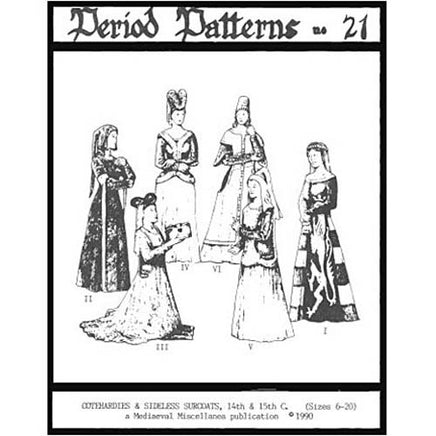
Ladies Classic Cotehardies
Period Patterns number 21, Cotehardies and Sideless Surcoats, c. 14th and 15th centuries, has 3 cotehardies and 4 sideless surcoats (sizes 6-20). These go great with Period Patterns 26, 90, 92 and 93.
Cotehardies were worn by both sexes of all ages and classes for over 200 years, from England to Bohemia, Norway to Spain. While there were regional variations, the basic cut of the cotehardie was the same throughout Europe. Originally a version of the tunic (Period Patterns #16), cotehardies differed in sleeve cut, variations, and tailor fit. Woman's cotehardies were fitted or even tight to the hips, then flared to the hem. They most often had long tight sleeves. They would be worn over a chemise (Period Patterns no. 90). Men's cotehardies, worn long or short, were initially tight to the hips, with long tight sleeves. They were worn over a shirt (Period Pattern no. 43) and hose (Period Pattern no. 101), often with hoods. In the first half of the 14th century a major style change occurred. With the invention of curved sleeve caps, gussets under the arm became unnecessary. Puffed chests and full sleeves became fashionable on men's cotehardies by 1350.
Sleeveless tunics or surcoats (from the French "sur le cote", i.e. over the cotehardie) were worn by both sexes as early as the 12th century, but with the return of crusaders from the Holy Land the style became wildly popular. The armholes deepened to the waist, then (particularly on woman's surcoats) to the hip, earning the name "sideless surcoats". These worn by women over very tight cotehardies, roused the ire of the church because their revealing cut was considered too seductive -the clergy dubbed these "the Gates of Hell".
Surcoats and cotehardies for both sexes could be plain and somber, or wildly colorful. Heraldic motifs were common on these garments. Both sexes began wearing houpelandes (Period Patterns no. 26) over a cotehardie after 1380. Cotehardies and surcoats as outerwear became unfashionable before 1425, with one exception. Cotehardies, with or without sideless surcoats, remained fashionable for women, as regal ceremonial garments, until well into the 16th century. When the houpelande went out of fashion, the cotehardie for women briefly re-emerged, with slight changes, as the kirtle (Period Pattern #51). Men's cotehardies had meanwhile evolved into the doublet (Period Patterns #43 & 53).
Zelikovitz Leathers is an Official Distributor of Mediaeval Miscellanea Period Patterns and stocks the full line of available patterns.
Mediaeval Miscellanea has created copyrighted Period Patterns for sewing authentic period clothing. The patterns, designed by professional costumers, are rigorously researched to ensure historical authenticity. Each package includes complete, full sized cutting patterns in all sizes listed on the envelope (which permits easier custom fitting; sizes are based on standard commercial pattern sizes and can easily be scaled up or down to create additional sizes). Detailed, fully illustrated, step-by-step sewing instructions are provided in addition to general instructions (seam finishes etc.), and most patterns include suggested pattern layout.
Each pattern package contains historical notes with illustrations from contemporary sources providing background information, as well as possible enhancements and variations. On the back of the package additional important information is provided including garment description (with country and approximate dates where possible), sizing, notions and yardage requirements for each size and suggested fabric type for each garment.
